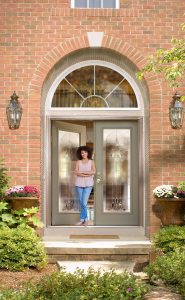Entry doors are often the focal point of your home. A big plus is that they offer an excellent return on investment. When visitors approach your house, the entry door is typically what draws their eye, so your door should be distinctive in order to make a good first impression. As a homeowner, you want your entry door to say your home is welcoming and well-cared-for.
Ultimate Customization
One of the things we like to tell our clients is to put a little of themselves into their entry door. There are many design elements that allow your front door to make a personal statement. For example, there are more than 30 different glass packages, over a dozen different door styles, multiple staining options, and in excess of 50 paint colors, all of which can be mixed and matched. If you’re spunky and outgoing, choose a vibrant door color. If you’re more low-key, a traditional wood grain or neutral-colored door may be your choice.
We’ve received many calls from homeowners who say, “I just need a door.” But there are so many other things to consider, depending on your personal preference, architectural style, color, and performance requirements.
Types of Entry Door Materials
There are three types of entry door materials to consider:
- Wood. Offering a very traditional look that provides a sense of warmth and richness, homeowners can choose from a variety of styles, including most wood species you can think of. Wood doors, which can be custom-made, need to be carefully finished (stained or painted) according to the manufacturer’s specifications, and periodic maintenance is required.
- Fiberglass. Available with an environmentally friendly polyurethane core, fiberglass doors provide insulation properties that are at least four times greater than those of wood doors. Low-maintenance fiberglass doors come factory-painted or-stained to provide years of lasting beauty. Featuring a high-impact compression-molded skin that won’t splinter, warp or rot, fiberglass entry doors come with architecturally correct, full-length composite stiles and top and bottom rails are standard. Wood grains that replicate the look of cherry, fir, mahogany, and oak are also available.
- Steel. We like to recommend steel doors for their incredible performance and beauty and the safety and security they provide. Be wary of the “insulated door” labels that you see at big-box stores, as these doors have fiberglass batts of insulation panels inside the door that can create an air pocket where condensation occurs, eventually resulting in rot. With a 100 percent foam-filled door, this doesn’t happen. Steel doors are also durable, resistant to splitting and cracking, and are energy efficient. They come pre-painted or pre-stained in a smooth or textured finish.

Glass & Hardware
Entry doors can have flat panels or high-definition panel profiles. Glass options include clear double-insulated glass or a variety of triple-glazed Sales Design Consultant glass styles. Homeowners have the option of choosing privacy ratings as well as choosing options in any size, shape, texture, or pattern. You can even choose designer glass, which can be etched, patterned, textured, beveled, and designed with simulated divided lites and grilles between the glass. Homeowners can also choose from brass or lead caning. These decorative glass designs are sealed between two panes of tempered “safety” glass, providing the energy efficiency of triple glazing.
Just like glass packages, door hardware comes in a variety of colors and shapes. Handles and hinges can be simple or ornate, and finishes run the gamut, including nickel, satin nickel, bright brass, antique brass, oil-rubbed bronze, matte black, and satin stainless steel.
Additional Options
Homeowners should also consider if they want to have a kick panel, peep hole, or mail slot and, depending on the size of the opening, sidelights and transoms. Many people prefer to add a storm door to their entry system for greater security, insulation, ventilation, and light. One caution is if you choose a full-view glass storm door and the door is facing west or south so that it receives direct sunlight, you want to make sure it’s vented. Otherwise, the glass will create a thermal pocket, trapping the heat and causing damage to the entry door.
With all the customization options available, our experience is homeowners either become very excited or very overwhelmed when selecting entry doors. That’s where a trained product specialist with an eye for design can help by explaining and offering ideas of what will look and work best with the architecture of the home and the performance standards desired. To speak to one of our specialists, call Callen at 414-765-2585 or visit us online.


